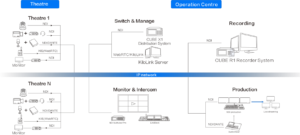
With the rapid development of multimedia technology, the application field of audio and video encoder technology is becoming more and more extensive.
H.264 (AVC) video encoder
The H.264 video encoder uses key technologies such as intra prediction, multi-reference frame motion estimation, and integer DCT transform to make it have higher video compression efficiency, which is 30% higher than the MEPG standard coding efficiency. Due to a limited network resources, adopting the H.264 standard has become a solution that meets user needs under limited bandwidth, and is also a low-cost solution.
Application scenario: Under the condition of low bandwidth, if you want to
transmit high-quality video and audio images via network and convert the
signal among SDI, HDMI, VGA, YPbPR, and CVBS (AV) interfaces to save the cost of video business operations, H.264 encoding transmission technology can be used.
HEVC/H.265 encoder
HEVC/H.265 is currently the mainstream standard for 4K resolution high-definition video. H.265 encoding can better support 4K technology which adopts a H.265 encoding standard based on the latest video encoding technology – HEVC – High Efficient Video Coding, can provide the same resolution video with a bit rate less than H.264, which can save a lot of storage space and bandwidth for video transmission.
Taking 4K ultra-high-definition video as an example, with a resolution of up to 3840×2160, if you encode in H.264 format, you need to provide at least a 100Mbps bit rate to ensure that the same picture quality.
If H.265 is used for encoding, the film volume will be reduced by half at the same bit rate without any loss in picture quality.
H.265 can transmit higher-quality network video under limited bandwidth, which means that only half the bandwidth of the original H.264 encoding can transmit the same quality video.
H.265 supports 4K (4096×2160) and 8K (8192×4320) pixels of ultra-high-definition video at the same time, and for standard TV 4K video like 3840×2160, it is not a problem.
As the data volume of 4K video is 4 to 8 times that of HD, a more efficient compression coding algorithm is needed. According to public information, the coding efficiency of H.265 is twice that of H.264.
Besides, since H.265 has a higher compression ratio than H.264, the file size of the former is only about half that of the latter, which saves bandwidth and is sought after by the majority of video production, playback, and image service companies. However, it has high requirements for CPU performance, and both encoding and decoding will bring high CPU load.
Application scenario: Under sufficient network bandwidth, transmitting high-quality and high-definition audio and video images via network can use H.265 encoding transmission technology. Currently, as a result, it is widely used in radio and television program production, surgery/medical, etc.










